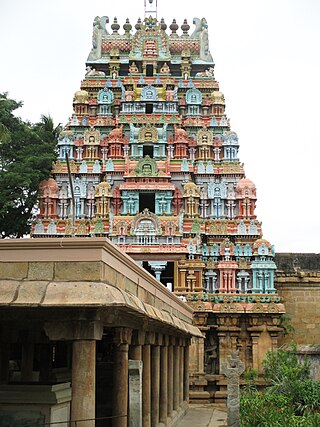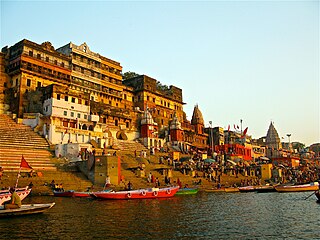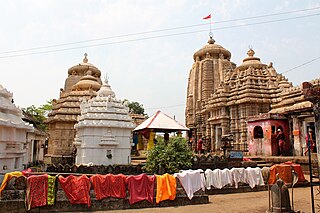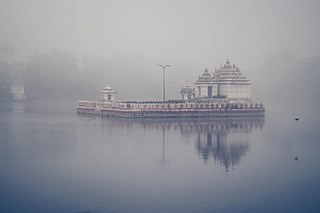
Jambukeswarar Temple, Thiruvanaikaval is a famous Shiva temple in Tiruchirapalli (Trichy) district, in the state of Tamil Nadu, India. Though it is that Kocengannan, one of the Early Cholas, have built this temple. It is located in the Srirangam island, which has the famous Ranganathaswamy temple.
Tourism in Odisha is one of the main contributors to the economy of Odisha, India, with a 500 km (310 mi) long coastline, mountains, lakes, natural biodiversity and rivers. Odisha is a major tourist destination in India, with various tourist attractions, including wildlife reserves, beaches, temples, monuments, the arts and festivals. Other than wildlife reserves, beaches, temples, monuments, the arts and festivals, the Odisha Tourism Development Corporation, a public sector undertaking of the Government of Odisha, is also developing the tourism sector of Odisha and India.

Ghats in Varanasi are riverfront steps leading to the banks of the Ganges river. The city has 84 ghats. Most of the ghats are bathing and puja ceremonial ghats, while two ghats, Manikarnika and Harishchandra, are used exclusively as cremation sites.

Manikarnika Ghat is one of the holiest cremation grounds among the sacred riverfronts (ghats), located on the Ganges, in the city of Varanasi in the Indian state of Uttar Pradesh. In Hinduism, death is considered a gateway to another life marked by the result of one's karma. It is believed that a human's soul attains moksha, and hence breaks the cycle of rebirth when cremated here.

The Nanjundeshwara Temple is an ancient temple dedicated to Shiva in the Hindu pilgrimage town of Nanjanagudu in Karnataka, India. It is located on the right bank of the Kapila River, a tributary of the Kaveri River. Nanjanagudu is also known as "Dakshina Prayaga" or "Prayag of South".
Jalesvara Siva Temple Precinct is a Hindu Temple dedicated to Shiva situated on the southern outskirt of the village Kalarahanga at a distance of 2.00 km from Patia and 6.00 km south of Chudangagada in the northern outskirt of Bhubaneswar, Odisha, India. The presiding deity is a Siva-lingam within a circular yonipitha inside the sanctum, which is 1.15 meters below the chandrasila. The sanctum measures 2.00 square meters.

The Kapilesvara temple is a Hindu temple dedicated to Shiva located in the south western outskirt of the village Kapilesvara, Old Town, Bhubaneswar, Odisha, India. It is located at the end of Kapilesvara road leading from Lingaraj temple to Kapilesvara Village. The presiding deity is a Siva-lingam at the center of a circular yonipitha inside the sanctum. It is a living temple, facing towards east and maintained by Kapilesvara Temple Trust Board. The temple is situated within the precinct along with 33 other monuments. The precinct is located on the northern embankment of Manikarnika tank over an area of 44.00 square metres.

Chintamaniswar Shiva Temple is a Hindu temple dedicated to Lord Shiva in Bhubaneswar, the capital of Odisha, India. It is at the end of the Chintamaniswar road branching from Cuttack-Puri road near the Old Station Bazar. The temple faces west and the enshrined deity is a Siva lingam with a yonipitha.
Sundaresvara Tank is located in the south of Sundaresvara Siva temple across the Sundaresvara road, Old Town, Bhubaneswar, the capital of Orissa. It is now under the care and maintenance of Sri Sri Dadhivamana Sundaresvara Mahadeva Trust Board. The tank is enclosed within a masonry embankment made of dressed laterite blocks. The exact date when the tank was built could not be ascertained. However the tank may be earlier or contemporaneous to the Sundaresvara Siva Temple which is ascribed to the 13th Century A.D. The tank is in use for ritual as well as normal bathing. The tank is under the Endowment Department and Sri Sri Dadhivamana Sundaresvara Mahadeva Trust Board.
Bakresvara / Kalika Siva Temple / Tirthesvara Temple The Kalika Siva Temple is located beyond the southern compound wall of Kapilesvara siva temple and close to the northern embankment of Manikarnika tank.The temple is facing towards west and the presiding deity of the temple is a Siva lingam within a circular yonipitha. The temple is made of sandstone. It was built around 10th / 11th Century A.D.
Siddhesvara Siva Temple is located inside the Kapilesvara temple precinct, Kapilesvara village, Old Town, Bhubaneswar. It was built in the 15th century AD. The temple is facing east and the presiding deity of the temple is a Siva lingam within a circular yonipitha, which is made of laterite. The cella of vimana is measuring 1.55 square m. The temple is made of sandstone and totally renovated one. It is under the care of Kapilesvara Temple Trust Board.
Vishnu Temple is located within the Kapilesvara Temple precinct Kapilesvara village, Old Town, Bhubaneswar. It was built in the 15th century AD. The temple is facing towards east and the presiding deities of this temple are two Vishnu images, and the image of Jagannatha, Balabhadra, Subhadra and Buddha. The sanctum measures 2.10 square m. The temple is made of laterite stone. It is under the care of the Kapilesvara Temple Trust Board.

Kotitirtha Tank is a sacred tank, used as a ritual bath in Hinduism, located near the Kotitirthesvara temple in the Kotitirthesvara lane, Old Town, Bhubaneswar, Odisha, India. It is now under the care and maintenance of the Kotitrithesvara Thakura Development Committee. The tank is enclosed within a masonry embankment made of dressed Laterite blocks.

Bindusagar Lake is located in the right side of the Talabazar road leading from Kedargouri Chowk to Lingaraja Temple, Old Town, Bhubaneswar. This road is also known as Bindusagar Road. It is now under the care and maintenance of Lingaraja Temple Administration. The tank is enclosed within a masonry embankment made of dressed laterite blocks. It is the largest water body of Bhubaneswar. All the rituals of Lord Lingarajaa are closely associated with this lake.
The Somabaresvara Siva Temple is located in the Kapilesvara temple precinct. The enshrined deity is a Sivalingam over a square yonipitha made of sandstone. The temple has a vimana in pidha order. It is triratha on plan and the temple is buried up to the baranda. The temple is facing towards west. The remaining part of the bada measure 0.78 m in height. The gandi measures 0.75 m having three receding tiers. Mastaka measures 0.50 m in height. The doorjamb measures 0.57 m in height x 0.38 m in width and the sanctum is 0.27 m below the ground level. The cella measures 0.75 square m whereas the vimana measures 1.15 square m. The temple is surrounded by Beharana mandapa in the west at a distance of 7.50 m, Kapila kunda in the east. Southern entrance of the Natamandapa of Kapilesvara temple in the north, Kala Bhairava temple is at a distance of 1.55 m.
Gangesvara Siva Temple is situated within a precinct on the left side of the Ganges–Yamuna road Old Town, Bhubaneswar, Orissa, India. It is located at a distance of 200 metres north-east of Lingaraj temple, 50 metres north of Lakhesvara temple across the road, 200 metres south of Subarnesvara and 100 metres east of Gourisankar temple. The temple is facing towards east. The presiding deity is a Siva lingam within a circular yonipitha. It is a living temple and maintained by the Ganga YamunaSangathana.

Uttaresvara Siva Temple is a 12th-century Hindu temple dedicated to Lord Siva located in Bhubaneswar, Odisha, India.
Yamesvara Tank is located in Yamesvara Patna, Old Town Bhubaneswar, Odisha, India. It is located in the left side of the Yamesvara Patna lane branching from Badheibanka Chowk to Kapilesvara. The tank is under Bharati Matha and it is now abandoned because the sewage water of the locality is discharging into the kunda. Hence it is also known as Nala kunda. The tank is enclosed within a masonry embankment made of dressed laterite blocks.
Sinduresvara Siva temple is located in village Sundarpada, Old Town, Bhubaneswar, Odisha, India. It is on the right side of the road leading from Lingaraj temple to Sundarpada. The enshrined deity is a circular yonipitha facing towards the north. The Siva lingam decayed in course of time. In April 2013 the villagers raised funds and reestablished new Shiv Linga. There are two entrances on the south-west and northwest corners provided with seven flights of steps leading down to the temple.

Bhima Kunda (tank) is located beyond the western compound wall of the Bhimesvara Temple precinct, in Kapila Prasad, Old Town, Bhubaneswar. It is now under the care and maintenance of Bhimesvara Temple Development Committee. The tank was excavated by cutting through the laterite bed rock. The embankment is made of dressed laterite blocks.











